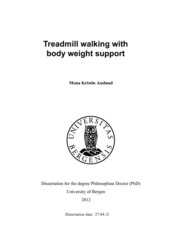Treadmill walking with body weight support
Abstract
Background: Rehabilitating walking in patients post-stroke with safe, task-specific, intensive training of sufficient duration, can be challenging. Body weight supported treadmill training (BWSTT) has been proposed as an effective method to meet these challenges and may therefore have benefits over training overground walking. However, walking characteristics should not be aggravated during BWSTT or require a long familiarisation time compared to overground walking. Objectives: To investigate kinematic walking characteristics during treadmill walking with body weight support (BWS), how kinematic characteristics stabilise during treadmill walking with BWS, and the consequences of altering walking speed and percentage of BWS during treadmill walking. Method: Cross-sectional, repeated measures designs were used. A body worn sensor assessed trunk acceleration. The effect of treadmill, harness and BWS-system were investigated in non-impaired participants. Ambulatory patients post-stroke were investigated to study kinematic characteristics during a five-minute familiarisation trial, how treadmill walking with BWS differed from overground walking, and the effect of altering speed and percent BWS. Results: Kinematic walking characteristics were affected by the treadmill, the harness and the BWS-systems in non-impaired participants. For patients post-stroke relatively stable walking patterns were achieved within a five-minute familiarisation trial. Kinematic characteristics differed between overground walking and walking on the treadmill with BWS, but were generally not aggravated. Altering walking speed affected kinematic characteristics more than altering BWS. Fast walking speed had a positive influence on several walking characteristics. Conclusion: Kinematic walking characteristics during walking on a treadmill with BWS are different compared to overground walking, and tend to be more normalised in ambulatory patients post-stroke. The advantages of BWSTT to practice safe walking with high intensity and long duration therefore make BWSTT a good alternative in walking rehabilitation for ambulatory patients post-stroke.
Has parts
Paper I: Aaslund, M. K. and Moe-Nilssen, R. Treadmill walking with body weight support. Effect of treadmill, harness and body weight support systems. Gait & Posture 28(2): 303–308, March 2008. Full text not available in BORA due to publisher restrictions. The article is available at: http://dx.doi.org/10.1016/j.gaitpost.2008.01.011Paper II: Aaslund, M. K., Helbostad, I. L. and Moe-Nilssen, R. Familiarisation to body weight supported treadmill training for patients post-stroke. Gait & Posture 34(4): 467–472, July 2011. Full text not available in BORA due to publisher restrictions. The article is available at: http://dx.doi.org/10.1016/j.gaitpost.2011.06.020
Paper III: Aaslund, M. K., Helbostad, I. L. and Moe-Nilssen, R. Characteristics of treadmill walking with body weight support in ambulatory patients post-stroke. Effect of walking speed and degree of body weight support. Full text not available in BORA.
